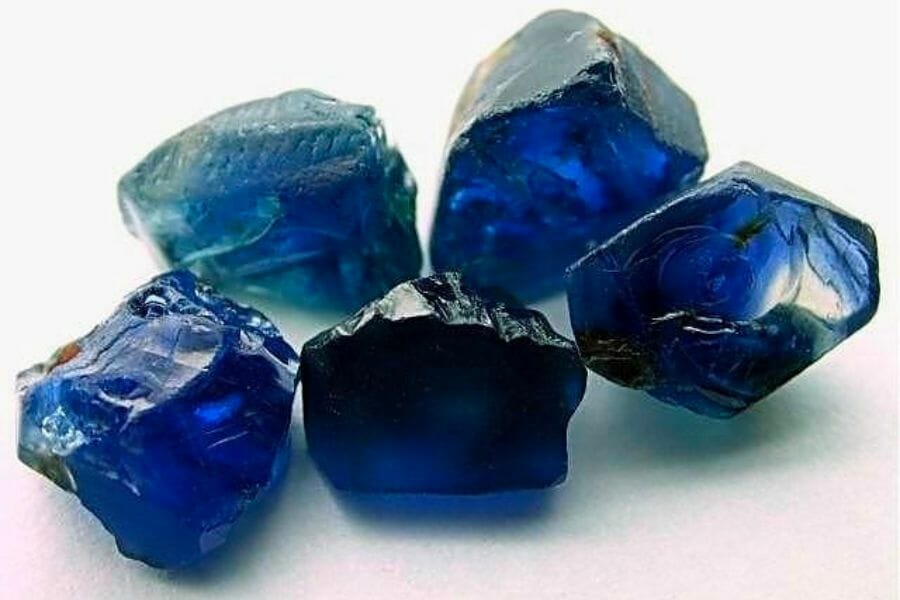Finding crystals can be a rewarding adventure, offering a unique way to explore the natural beauty and geology of the region. Whether you’re a seasoned rockhound or just getting started, knowing where to look is key to uncovering these hidden treasures.
In this state, a variety of locations provide opportunities to discover different types of crystals. From rocky outcrops in the mountains to stream beds that carry sparkling surprises, each area offers its own unique finds for those willing to search.
We can help you get started with some places you can explore for crystals below!
Crystals you can find in the US
The United States offers a wide range of crystals that reflect its diverse geology. From vibrant gems to more subtle mineral formations, there’s something to discover in nearly every region.
Calcite
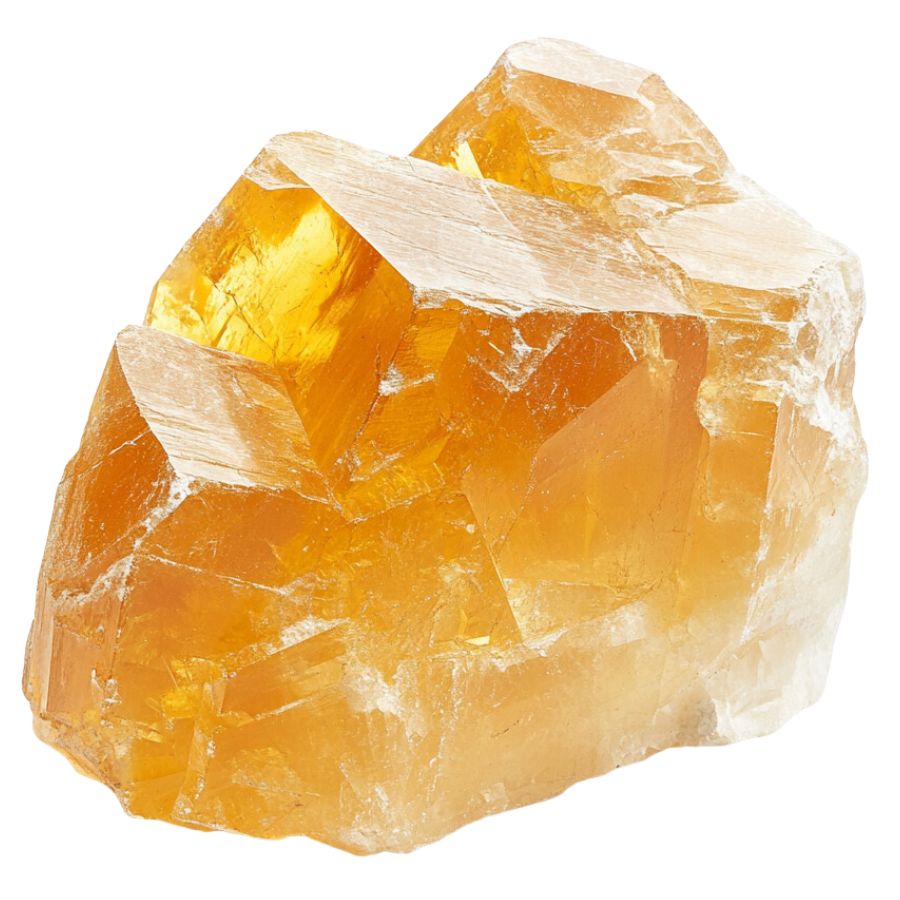
With a variety of forms and a unique property of double refraction, calcite allows objects viewed through the crystal to appear doubled. This mineral can appear in a spectrum of colors, with pure forms typically being transparent or white.
In addition, calcite reacts vigorously with acids, which aids in distinguishing it from other minerals. It also frequently contributes to the structure of sedimentary rocks such as limestone.
Gypsum
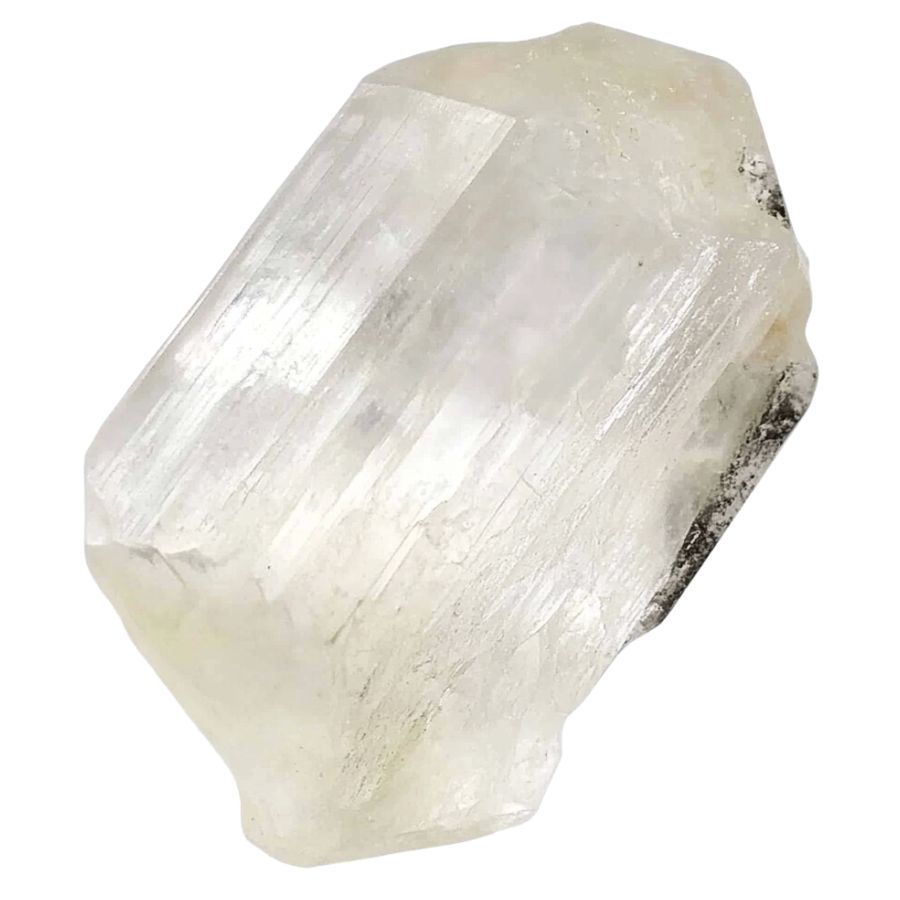
Gypsum’s notable softness allows it to be easily scratched with just a fingernail, often presenting as white or very light-colored in its pure form.
It manifests in both crystalline forms, like selenite, and massive forms such as alabaster, making it versatile in use and appearance.
Gypsum is also essential in the construction industry and is a key component in the manufacture of plaster and drywall.
Fluorite
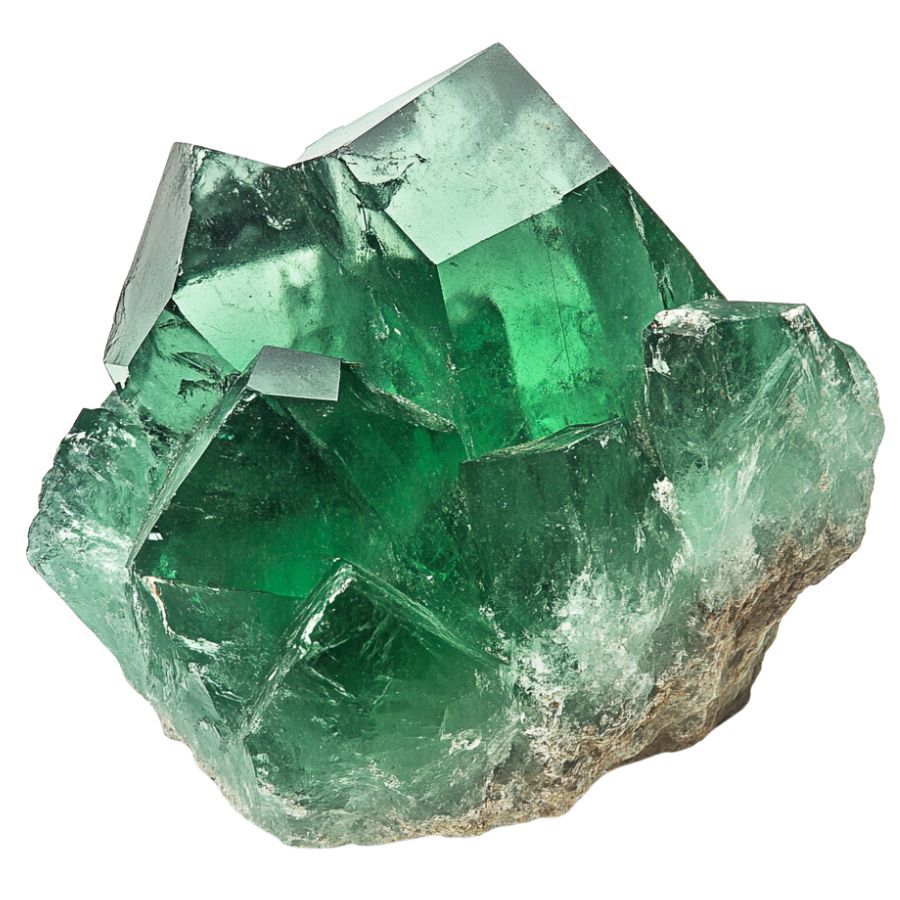
Fluorite comes in a wide range of vibrant colors, including purples, greens, blues, and yellows, and is known for forming in well-defined cubic crystals.
Beyond this, fluorite exhibits fluorescence under ultraviolet light! It can also be used in various industrial applications, including as a flux in steelmaking.
Galena
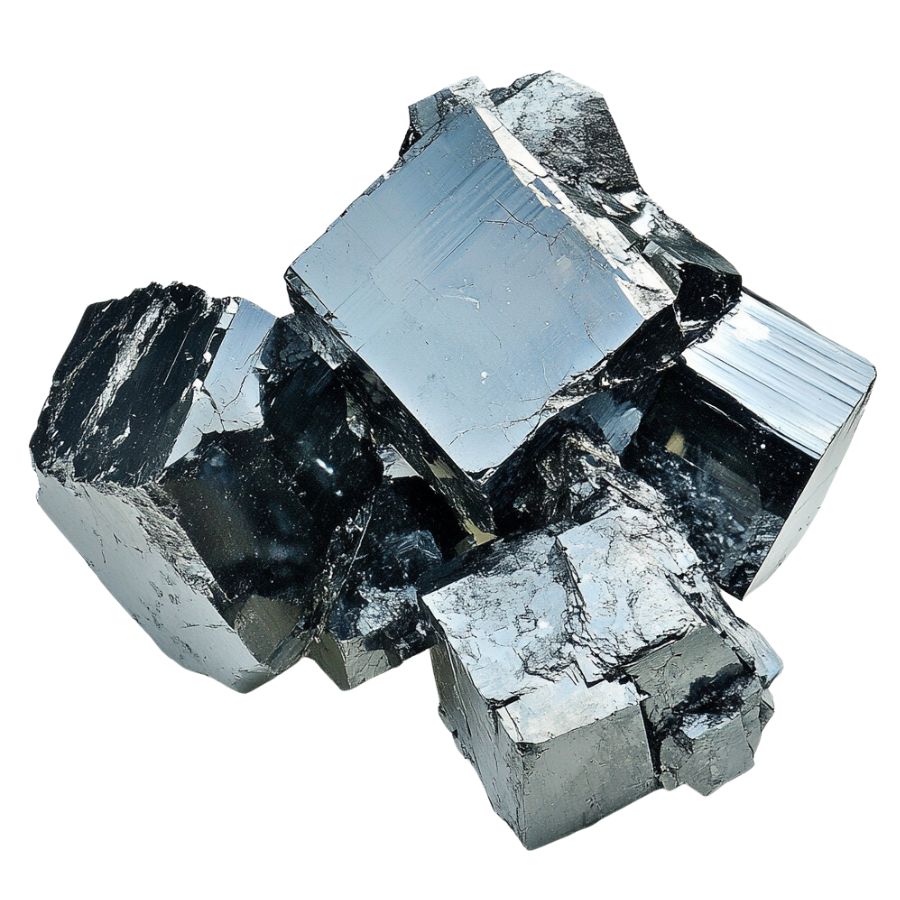
Galena distinguishes itself with a metallic luster and high density, typically found in a cube-like form. It serves as the primary ore of lead, making it important in the metal industry, while its shiny, silver color attracts collectors.
Not only does its appearance make it a subject of interest, but its weight and texture provide tangible lessons in mineral density and metallic properties. Galena also often contains traces of silver, adding to its commercial and educational value.
Corundum
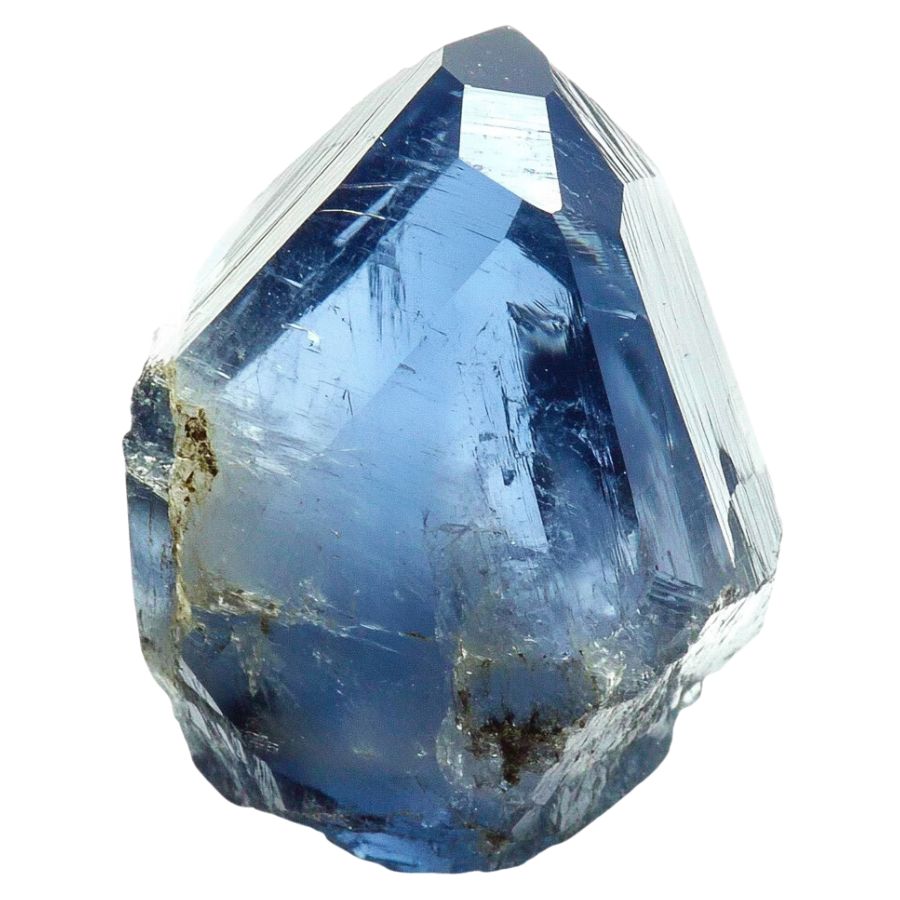
Corundum is a mineral that comes in a variety of colors, though it is typically transparent or gray. Its most famous forms are sapphires and rubies, which are prized for their vibrant blue and red hues.
The mineral is known for its remarkable hardness, ranking just below diamond on the Mohs scale. This durability makes corundum ideal for industrial abrasives and cutting tools, as well as a popular choice for fine jewelry.
Quartz
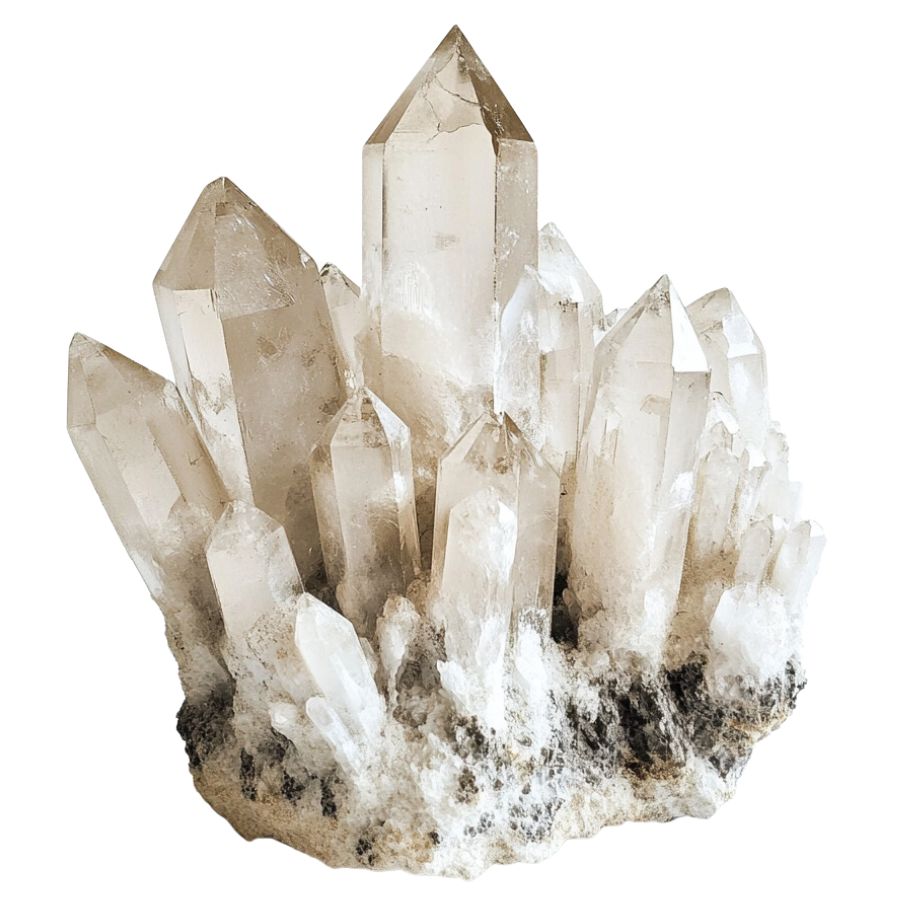
Quartz is among the most common minerals in the Earth’s crust and is prized for its durability and variety. It forms in a wide range of colors and types, from clear rock crystal to purple amethyst.
The mineral is notable for its hardness and durability, which contribute to its use in a variety of applications. Quartz is also popular in the manufacturing of electronics and watches due to its piezoelectric properties, which allow it to convert mechanical pressure into electrical energy.
Pyrite
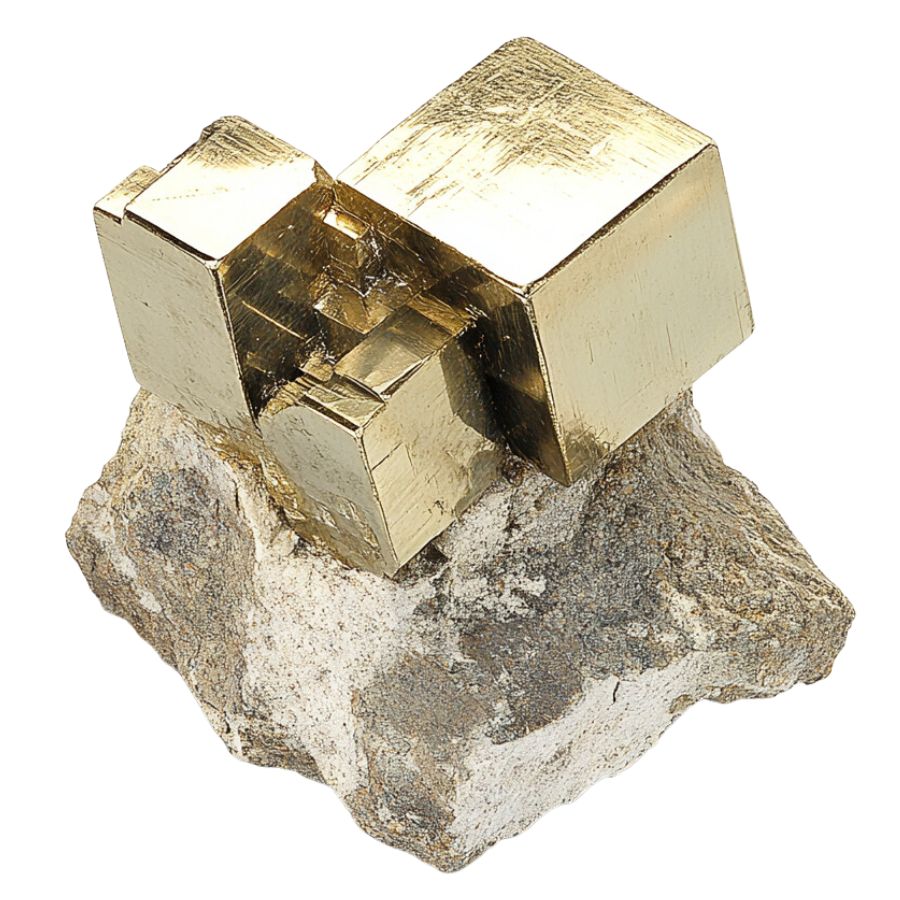
Often mistaken for gold due to its metallic luster and pale brass-yellow hue, pyrite is known colloquially as “fool’s gold.” Its characteristic cube-shaped crystal formations look man-made but are actually completely naturally formed!
Pyrite also has historical importance in producing sulfur dioxide for sulfuric acid production.
Rhodochrosite
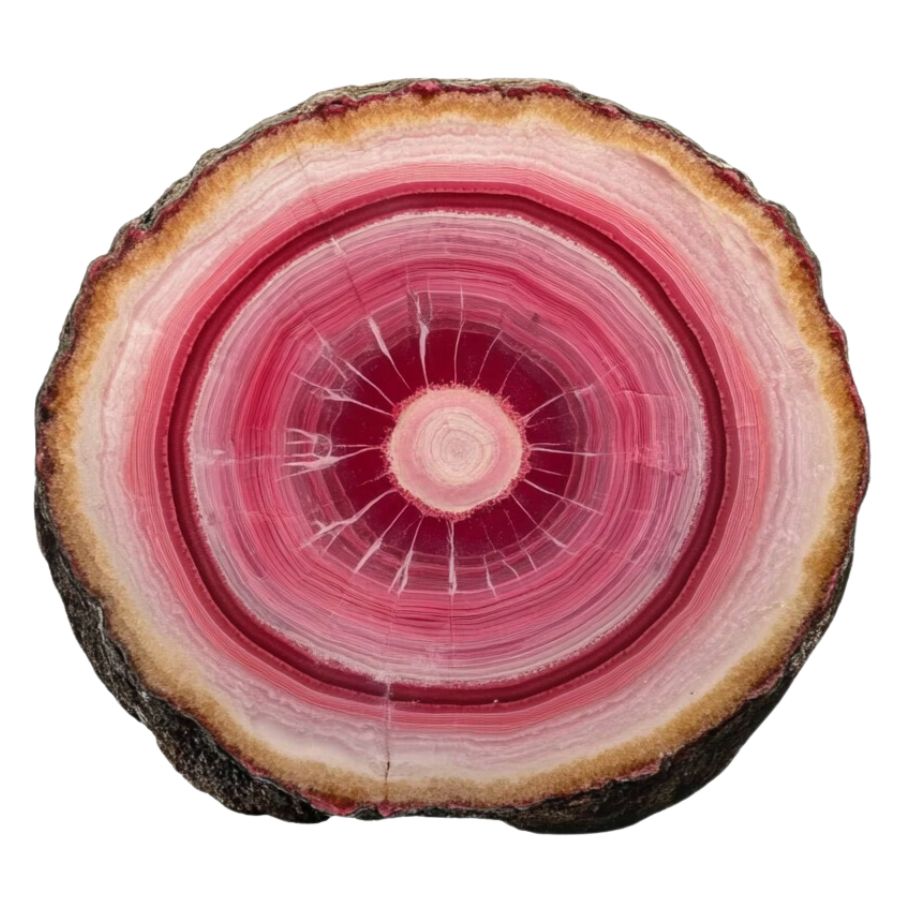
Rhodochrosite stands out with its rich pink and red hues, making it highly desirable as both a mineral specimen and a gemstone.
It typically forms in layered or stalactitic structures, with bands of colors that showcase how it grew over millions of years.
Beyond its beauty, rhodochrosite is significant as the main source of manganese, an essential element used in metal alloys.
Rhodonite
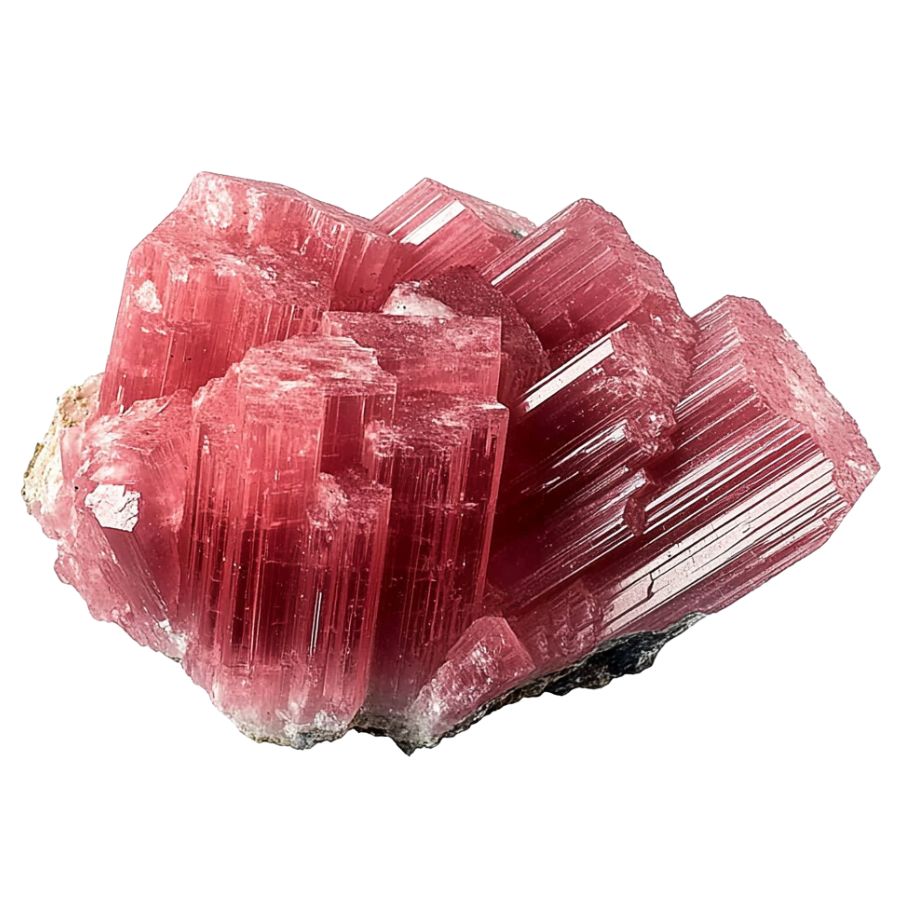
Appreciated for its deep pinks and reds, often complemented by black manganese oxide veins, rhodonite presents a dramatic appearance. It is typically found in metamorphic rocks and is used both as an ornamental stone and in jewelry.
In geology, rhodonite is significant for its role in metamorphic processes and its association with other manganese-rich minerals. It can be found in metamorphosed sedimentary rocks and is sometimes used as an indicator of the presence of manganese deposits.
Vivianite
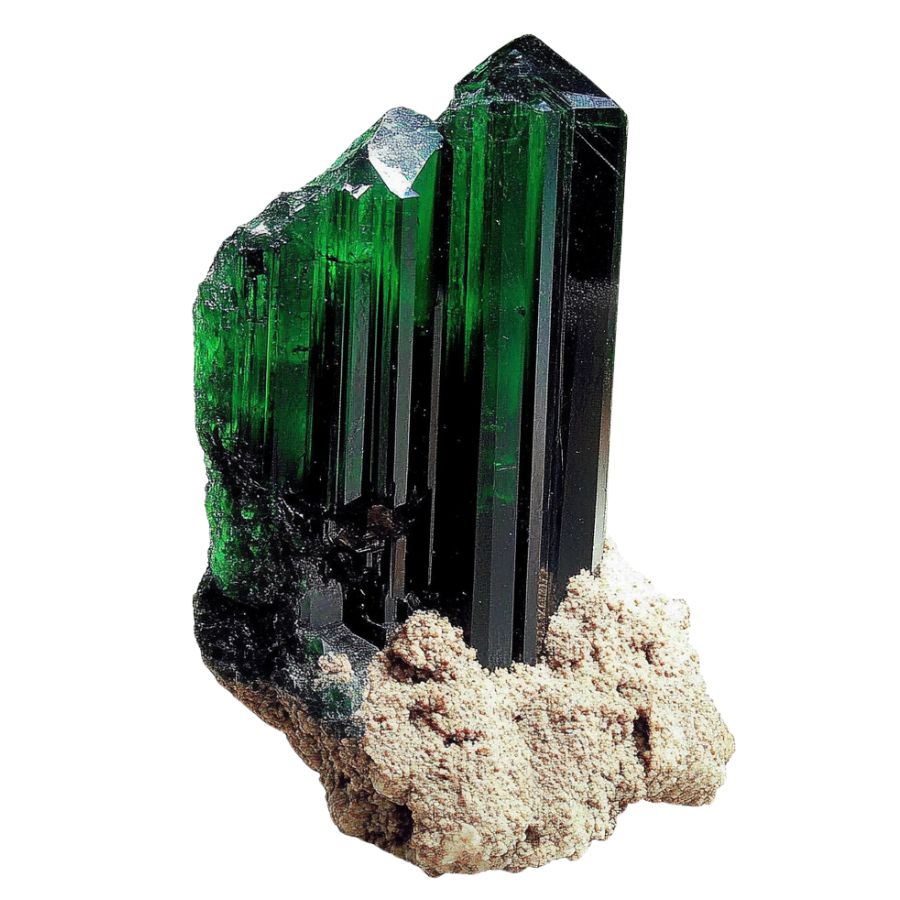
Vivianite, an iron phosphate mineral, emerges in low-oxygen environments like peat bogs or iron-rich deposits. Its striking blue to green color, which can change to a lighter shade over time due to oxidation, makes it a distinctive mineral.
Found in various geological settings, vivianite provides clues about the local conditions and the presence of phosphate deposits.
The Types of Alabama Crystals You Can Find
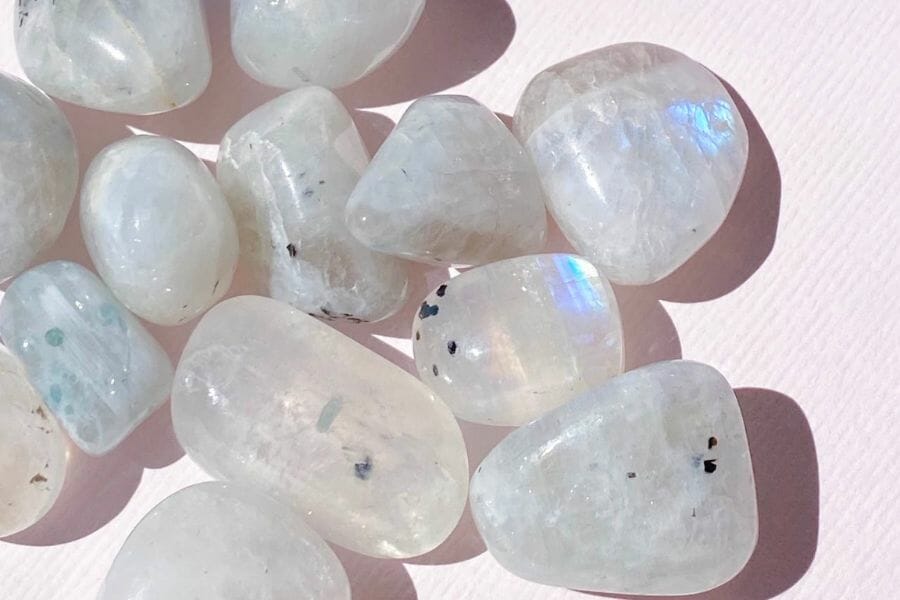
Alabama is home to some of the most beautiful and unique crystals in the world, making it a popular destination for crystal hunters and enthusiasts. Each crystal has its own unique characteristics, making them a fascinating subject for collectors and researchers alike. The beauty of Alabama’s crystals is not only in their visual appeal, but also in the energy and healing properties they possess. Here are the different types of crystals you’ll find here:
Rare crystals found in Alabama
- Amethyst
- Aquamarine
- Carnelian
- Celestite
- Moonstone
- Ruby
- Sapphire
- Topaz
- Turquoise
More common crystals found here
- Agate
- Apatite
- Azurite
- Calcite
- Chalcedony
- Chalcopyrite
- Copper
- Diamond
- Epidote
- Fluorite
- Galena
- Garnet
- Hematite
- Jasper
- Kyanite
- Malachite
- Muscovite
- Onyx
- Pyrite
- Quartz
- Rhodonite
- Rutile
- Tourmaline
- Unakite
- Vivianite
What rough crystals look like
When you’re out looking for crystals on your own it’s important to know what you’re looking for. This is what you need to look out for:
Look for exteriors like this
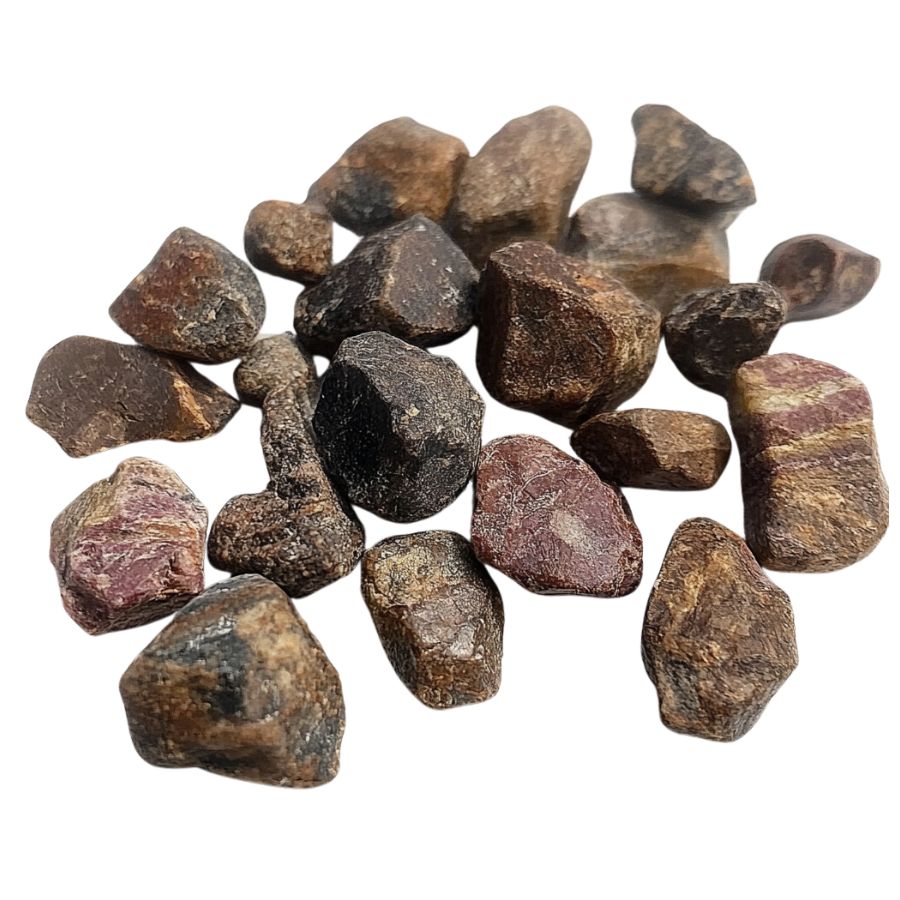
When you’re out searching for crystals in the wild, it’s essential to keep in mind that what you find won’t look like the polished stones you see in stores. One important tip is to consider what certain crystals look like in their raw, natural form.
Without the shine and smooth finish, crystals might appear rough, with jagged edges or earthy tones masking their true beauty. Understanding this can help you spot potential finds that might otherwise be overlooked.
Examine the crystal structure and shape
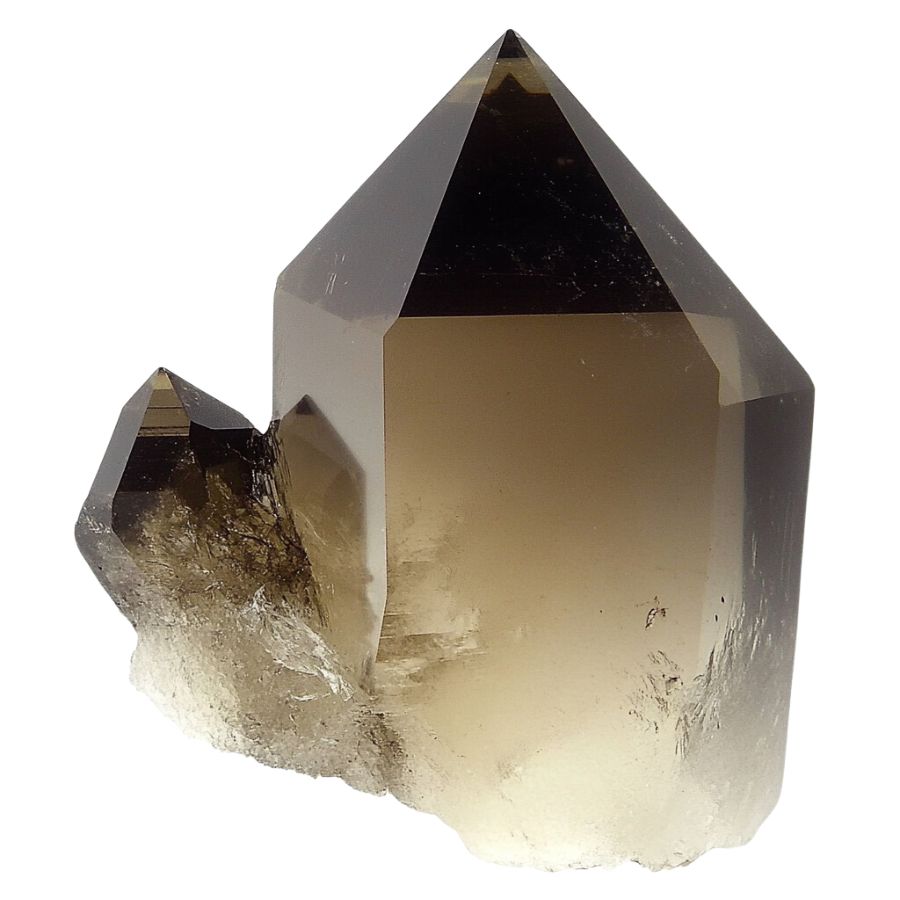
Crystals often form in specific geometric patterns that can be key to identifying them. For example, quartz is known for its hexagonal prisms, while halite typically forms cubic shapes.
By recognizing these distinct patterns, you can differentiate between various types of crystals and better understand what you’ve found.
Observe color
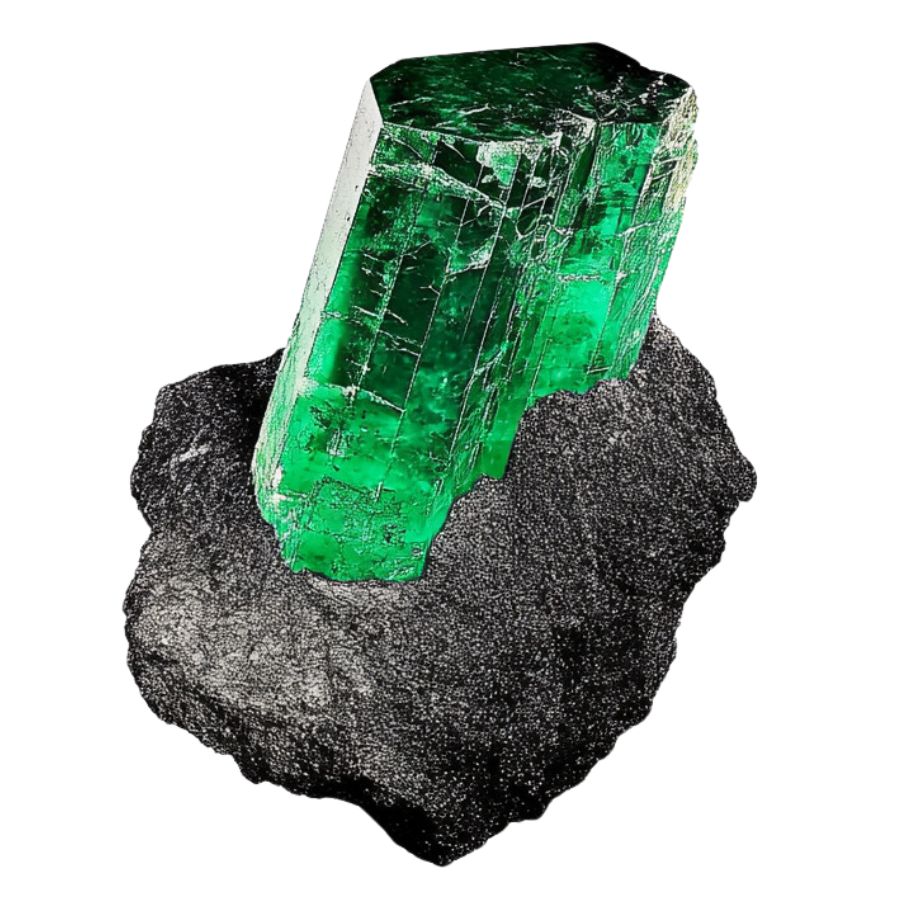
Some crystals are known for their distinct hues, like the deep purple of amethyst or the vibrant green of emerald. However, not all crystals will have strong colors; some may be clear or only slightly tinted.
Check the luster
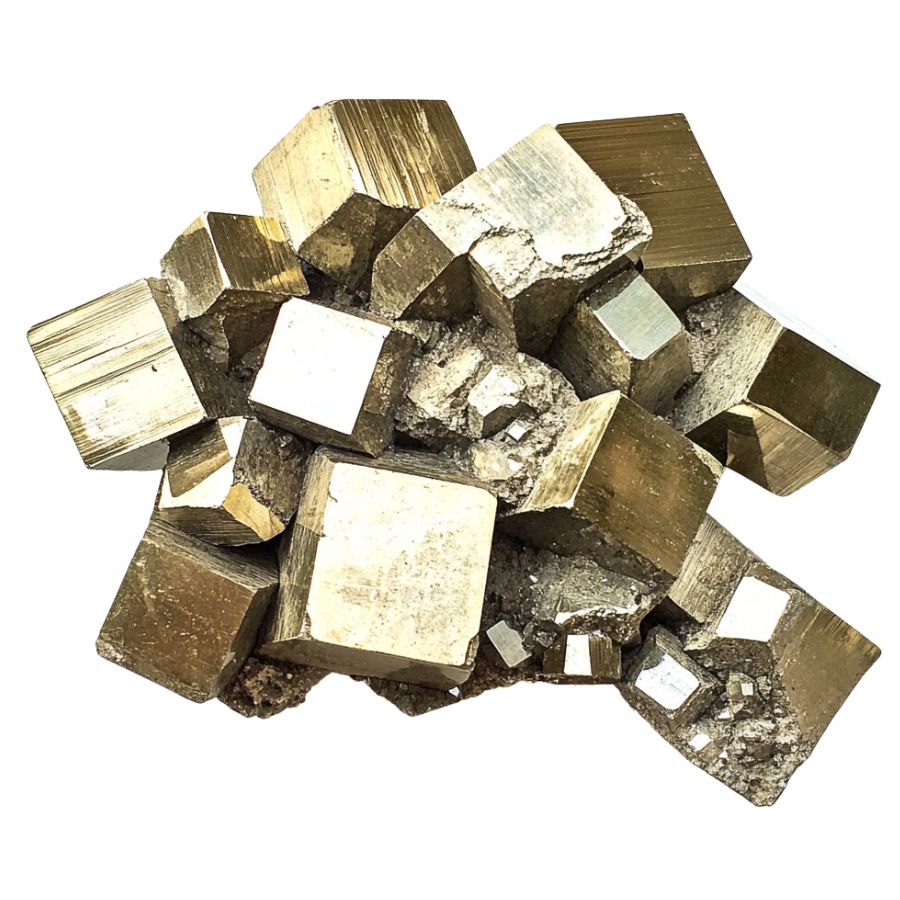
Luster refers to how a crystal’s surface interacts with light. Some crystals might have a shiny, glassy luster, while others may appear metallic or dull. This characteristic can help you determine the type of crystal you’ve found.
However, it’s important to remember that luster isn’t always obvious right away. In some cases, a crystal’s true luster will only become apparent after it’s been cleaned or polished, so keep this in mind as you examine your finds.
Evaluate the transparency
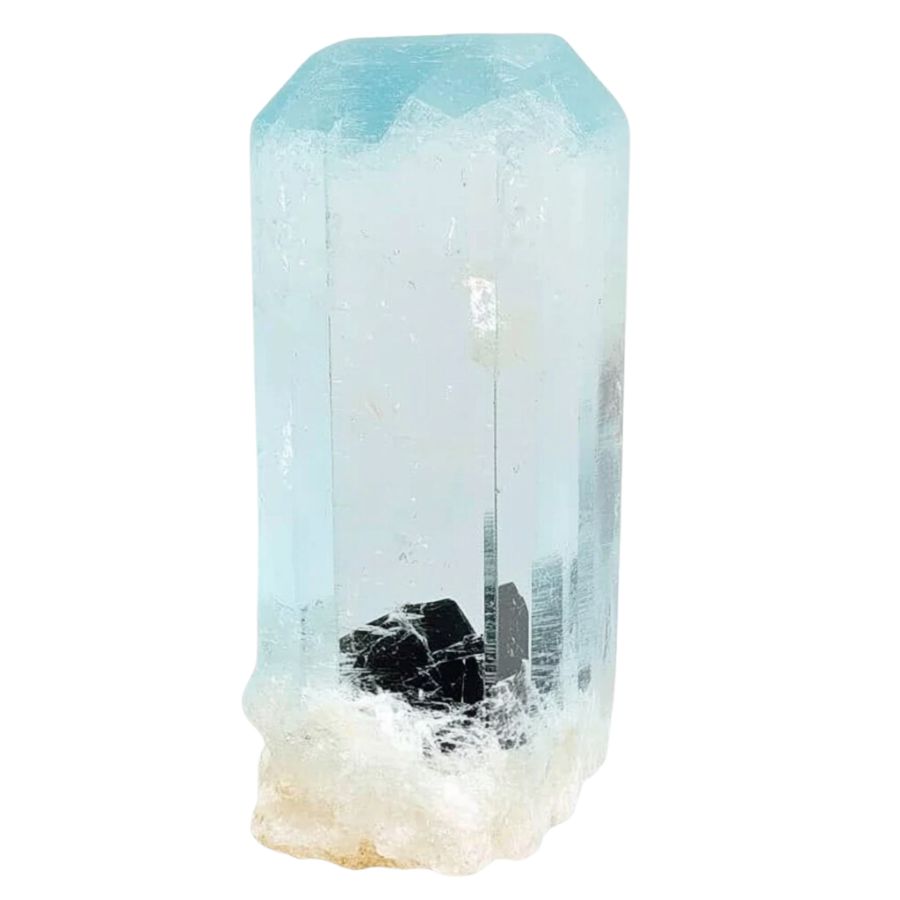
Pay close attention to how much light passes through the crystal. Some crystals are completely clear, allowing light to pass through easily, while others may be opaque and block light entirely.
You might also encounter crystals with translucent edges but opaque centers. These variations in transparency can offer valuable clues about the type of crystal you’ve found, making it easier to identify and appreciate your discovery.
A Quick Request About Collecting
Always Confirm Access and Collection Rules!
Before heading out to any of the locations on our list you need to confirm access requirements and collection rules for both public and private locations directly with the location. We haven’t personally verified every location and the access requirements and collection rules often change without notice.
Many of the locations we mention will not allow collecting but are still great places for those who love to find beautiful rocks and minerals in the wild without keeping them. We also can’t guarantee you will find anything in these locations since they are constantly changing.
Always get updated information directly from the source ahead of time to ensure responsible rockhounding. If you want even more current options it’s always a good idea to contact local rock and mineral clubs and groups
Tips on where to look
Having a better idea of where to look can greatly narrow down your search and increase your chances of finding crystals. By focusing on environments where crystals are likely to be exposed, you can spend less time searching and more time discovering.
Outcrops and Exposed Rock
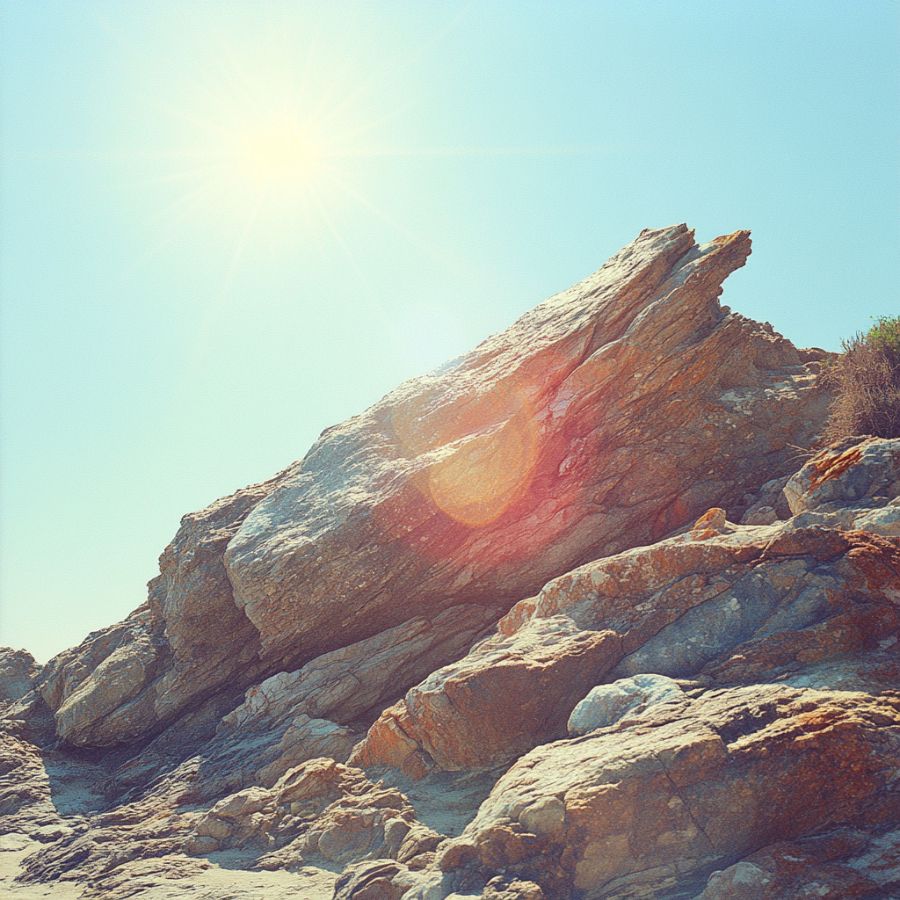
Rocky outcrops are prime locations for finding crystals and minerals. Search along the edges of outcrops, particularly where erosion has worn away the surrounding soil, revealing the rock underneath.
Pay close attention to any visible cracks, crevices, or small cavities within the outcrop, as these are often where crystals develop and can be extracted with minimal effort.
Stream Beds and Gravel Deposits
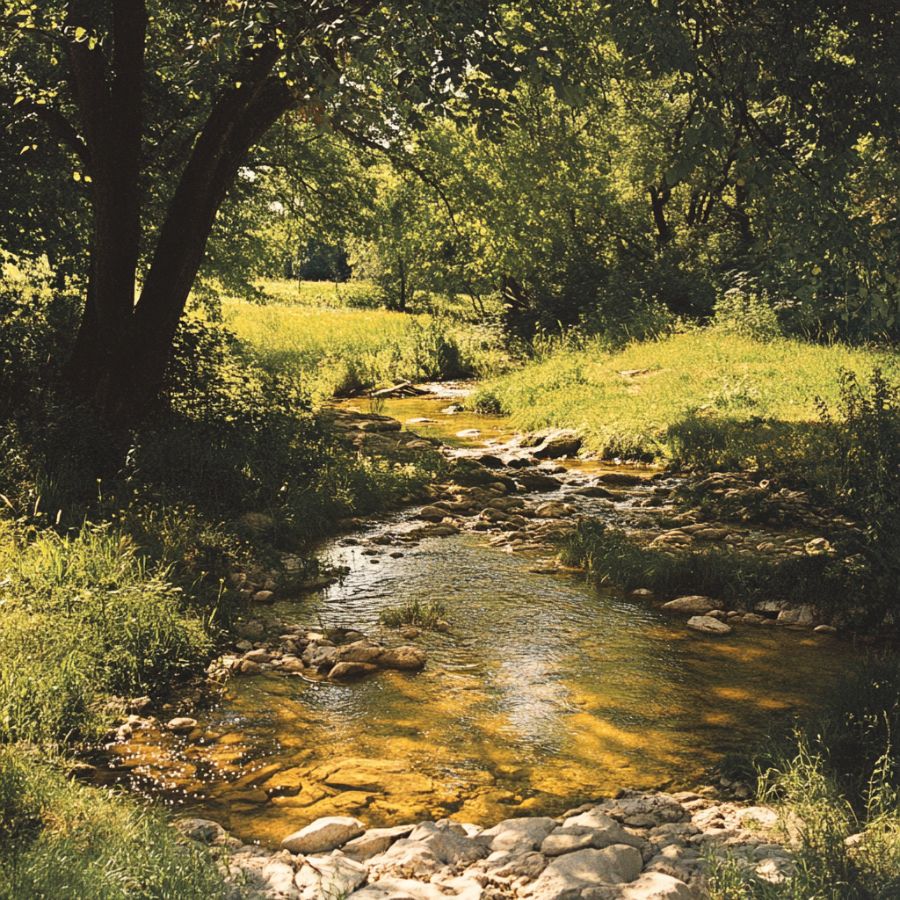
Stream beds are dynamic environments where water flow constantly shapes the landscape. Over time, water can erode rocks upstream, breaking them down and carrying mineral fragments, including crystals, downstream.
When searching in these areas, look for spots where the current has slowed, such as bends in the stream or areas behind large rocks, as these are prime locations for deposits.
Quarries and Mines
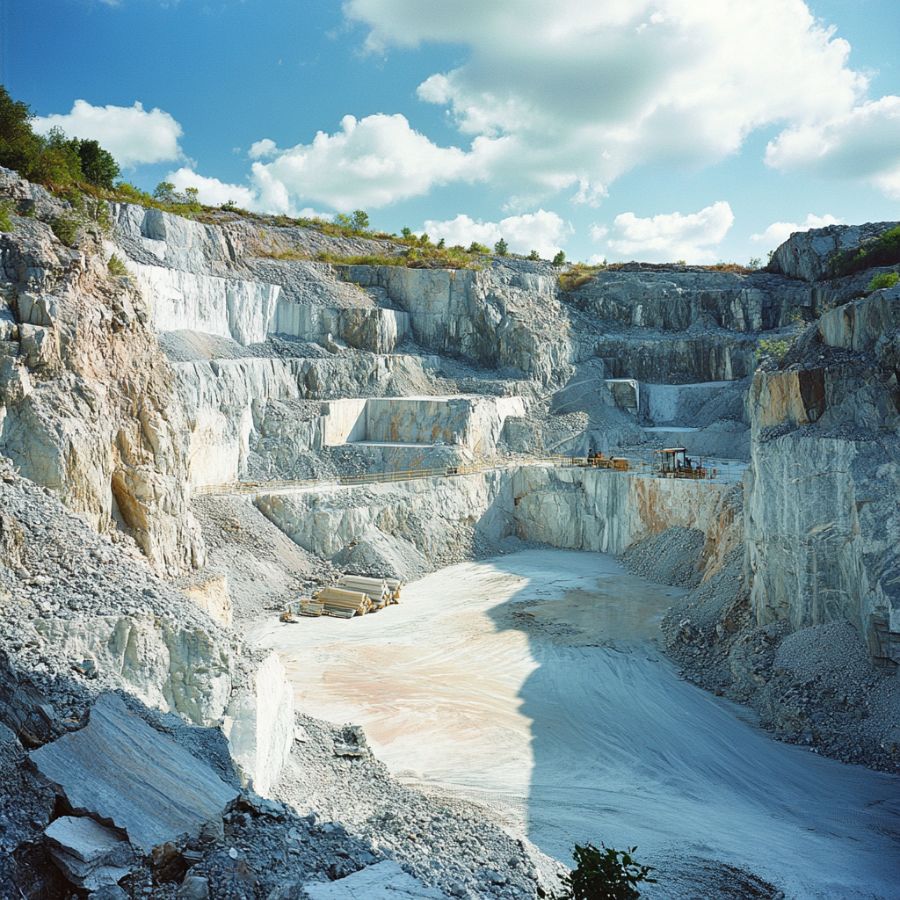
Quarries and mines are excellent places to search for crystals because they expose deep layers of rock that would otherwise be hidden beneath the surface. These sites often contain a variety of minerals and crystals that have been brought to the surface during excavation.
Pay attention to tailings piles, where waste rock is discarded, as they often contain overlooked or broken crystals. Always prioritize safety when exploring these areas and ensure that you have permission to search.
Road Cuts and Construction Sites
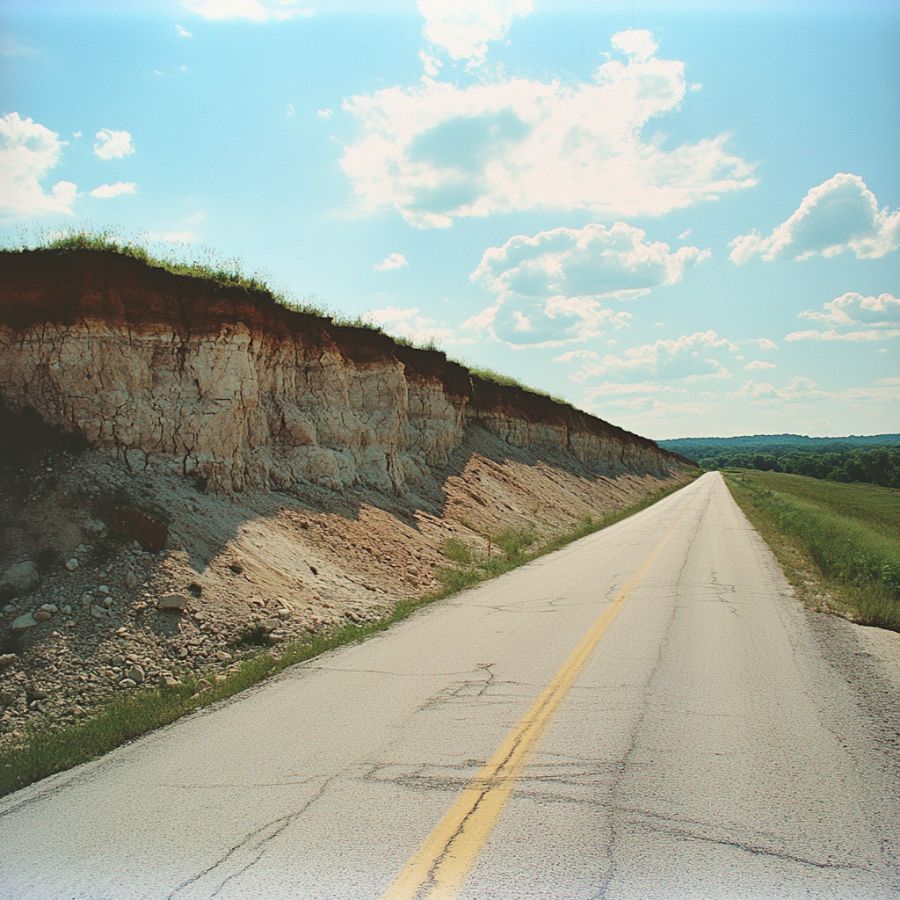
As roads are cut through hillsides or construction projects dig deep foundations, layers of rock and soil that have been undisturbed for millions of years are suddenly exposed.
Look for freshly exposed rock faces, especially where blasting has occurred, as this can create fissures or expose pockets filled with crystals. Be cautious around active construction sites, and always seek permission before exploring.
Mountainous Areas

In mountainous regions, erosion caused by wind, rain, and ice can wear away the softer rock, exposing harder crystals that have formed within. Focus on weathered and broken rock formations.
Look for scree slopes, where loose rock has accumulated at the base of cliffs. Additionally, areas near fault lines or volcanic vents are particularly promising, as they often have a higher concentration of minerals.
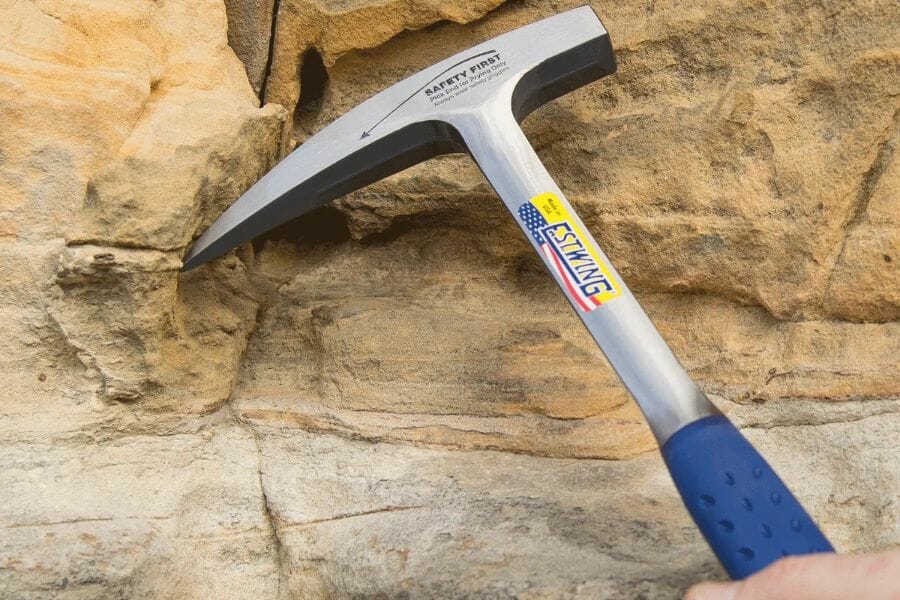
The tools every crystal hunter will need
When you're out looking for crystals having the right tools for the job is very important. You don't need a lot for most trips but there are a handful that are critical and will make your life a lot easier.
We get asked a lot about the equipment we use. Over the years we've found a handful of tools that we recommend to both new and experienced crystal miners which we outline in great detail in our complete rockhounding equipment guide. These are quality options that also happen to be relatively inexpensive.
Below are the basic tools that make your life so much easier and save you a ton of time. Check out the full guide to see everything we recommend bringing. One quick note, as an Amazon Associate I earn from qualifying purchases but we try very hard to only recommend gear we would use ourselves and often recommend brands you can't find on Amazon.
At a minimum you should have:
1 - Sturdy rock hammer: The Estwing Rock Pick is our standard
2 - Rugged chisels: Try Kendo' 3-piece Chisel Set
3 - Compact shovel: The Koleiya 28-inch shovel works well
4 - Rock screen pan: The Wazakura Soil Sieve Set fits the bill
5 - Eye protection: DeWalt Safety Glasses are cheap and comfortable
6 - Head protection: Malta's Safety Helmet has been our go-to
7 - Jewelers lens with at least 20x magnification: Jarlink's Jewelers Loop is perfect
The crystal-finding books that we use most
There are also a few books that have been extremely helpful in the search for gems. These books have great recommendations and tips:
National Audubon Society Field Guide to Rocks and Minerals: North America
Southeast Treasure Hunter's Gem & Mineral Guide
Earth Treasures: The Southeastern Quadrant
We provide links to find these tools on Amazon but some can also be found at your local hardware stores. For more recommendations check out the link to our full tool guide above.
Alabama Crystal Mining Laws And Regulations
Crystal mining in Alabama is perfectly legal for as long as you comply with our state’s laws regarding it. If you’re unaware of these laws, you may checkout the Alabama Department of Conservation and Natural Resources (ADCNR) which regulates crystal hunting here.
As a general rule, you should get the necessary permissions and permits for concerned government offices in the area that you will mine. For private lands, the permission of the owner is strictly required.
- The extensive local experience and understanding of our team
- Input from multiple local crystal hunters and crystal collecting groups
- The accessibility of the crystal mining locations
- Safety and potential hazards when collecting
- Private and public locations
- A desire to include locations for both experienced crystal hunters and those who are just starting out
Using these weights we think we’ve put together the best list out there for those who love finding new crystals for our collections!
The Best Locations For Crystal Mining in Alabama
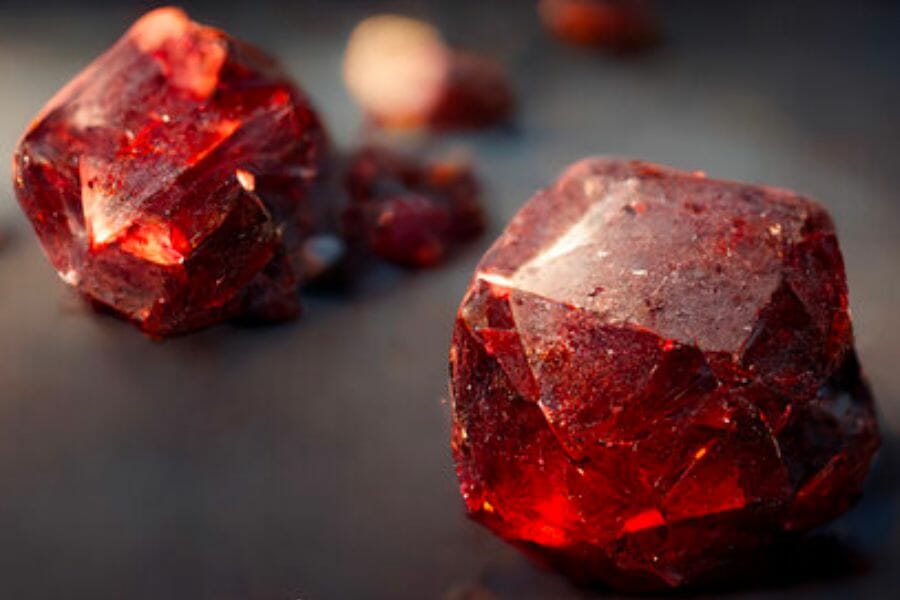
We selected our top 5 recommended places for crystal mining here based on our experiences and on the recommendations of our fellow experienced collectors and enthusiasts.
Always Confirm Access and Collection Rules!
Before heading out to any of the locations on our list you need to confirm access requirements and collection rules for both public and private locations directly with the location. We haven’t personally verified every location and the access requirements and collection rules often change without notice.
Many of the locations we mention will not allow collecting but are still great places for those who love to find beautiful rocks and minerals in the wild without keeping them. We also can’t guarantee you will find anything in these locations since they are constantly changing.
Always get updated information directly from the source ahead of time to ensure responsible rockhounding. If you want even more current options it’s always a good idea to contact local rock and mineral clubs and groups
Lake Martin is Our Favorite Crystal Mine in Alabama
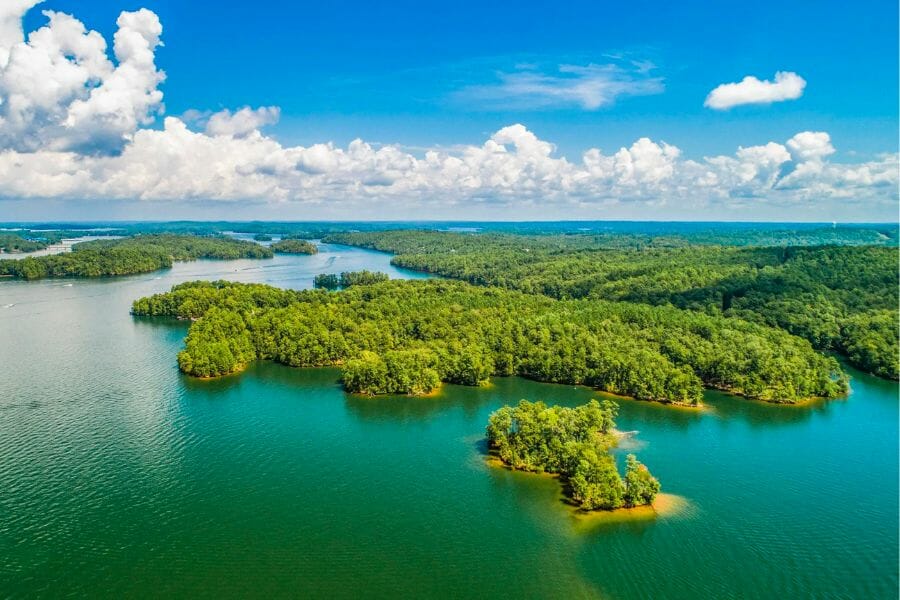
Tallapoosa, Elmore, and Coosa Counties, AL
One of the best crystal hunting locations in our state is Lake Martin. In fact, this is also one of the great places to find high-quality gems in Alabama. Created in 1926, this man-made lake was created by damming the Tallapoosa River. Since then, Lake Martin has become a beloved recreational spot for fishing, boating, and, of course, crystal hunting.
Lake Martin is located in the foothills of the Appalachian Mountains, providing a unique landscape for crystal hunters. Many spots around the lake prove to be abundant with crystals: the banks of the lake, the creeks that feed into it, and the areas surrounding the many small islands scattered throughout the lake. Aside from its rich resources, this location is also incredibly scenic and peaceful.
To get here, start by heading to the town of Dadeville. From there, follow the signs to the lake, and be sure to bring all the necessary gear for a day of crystal hunting. Once you arrive, take some time to explore the area and get a feel for the different types of rocks and formations here.
Where we found crystals at Lake Martin
We had the best time and success exploring Lake Martin for crystals, especially when we explored the outcrops on west shores, access areas on east shores, and south of the lake along river. Here, you can find different crystals, like Epidote, Hematite, Quartz, Ruby, Sapphire, and Unakite.

The tools every crystal hunter will need
When you're out looking for crystals having the right tools for the job is very important. You don't need a lot for most trips but there are a handful that are critical and will make your life a lot easier.
We get asked a lot about the equipment we use. Over the years we've found a handful of tools that we recommend to both new and experienced crystal miners which we outline in great detail in our complete rockhounding equipment guide. These are quality options that also happen to be relatively inexpensive.
Below are the basic tools that make your life so much easier and save you a ton of time. Check out the full guide to see everything we recommend bringing. One quick note, as an Amazon Associate I earn from qualifying purchases but we try very hard to only recommend gear we would use ourselves and often recommend brands you can't find on Amazon.
At a minimum you should have:
1 - Sturdy rock hammer: The Estwing Rock Pick is our standard
2 - Rugged chisels: Try Kendo' 3-piece Chisel Set
3 - Compact shovel: The Koleiya 28-inch shovel works well
4 - Rock screen pan: The Wazakura Soil Sieve Set fits the bill
5 - Eye protection: DeWalt Safety Glasses are cheap and comfortable
6 - Head protection: Malta's Safety Helmet has been our go-to
7 - Jewelers lens with at least 20x magnification: Jarlink's Jewelers Loop is perfect
The crystal-finding books that we use most
There are also a few books that have been extremely helpful in the search for gems. These books have great recommendations and tips:
National Audubon Society Field Guide to Rocks and Minerals: North America
Southeast Treasure Hunter's Gem & Mineral Guide
Earth Treasures: The Southeastern Quadrant
We provide links to find these tools on Amazon but some can also be found at your local hardware stores. For more recommendations check out the link to our full tool guide above.
Black Warrior River
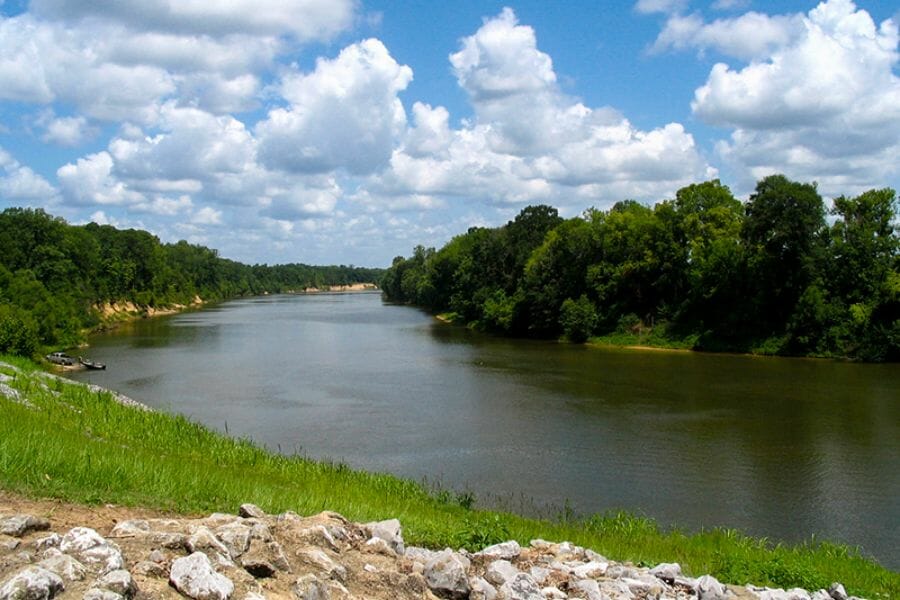
West-Central Alabama
The Black Warrior River was named after the Native American tribe that once inhabited the area, and it played a significant role in the Civil War. Today, it’s known for its recreational opportunities, including crystal hunting.
This river is located in the northern part of our state, winding its way through the Appalachian Mountains. Because of this, you can expect that the area is incredibly scenic, with beautiful views of the river and surrounding mountains. It’s also home to an abundance of wildlife, making for a truly immersive outdoor experience.
If you wish to visit here, head to the town of Tuscaloosa. From there, you can access the river at various points, including Oliver Lock and Dam, which is a popular crystal hunting spot as well.
Where we found crystals at Black Warrior River
We highly recommend exploring the mines and pits along the Black Warrior River between Brookwood and Peterson, where you can find a variety of crystals like Agate, Chalcedony, Jasper, Kyanite, and Vivianite.
Read our guide to know just how much are crystals worth.
Hog Mountain
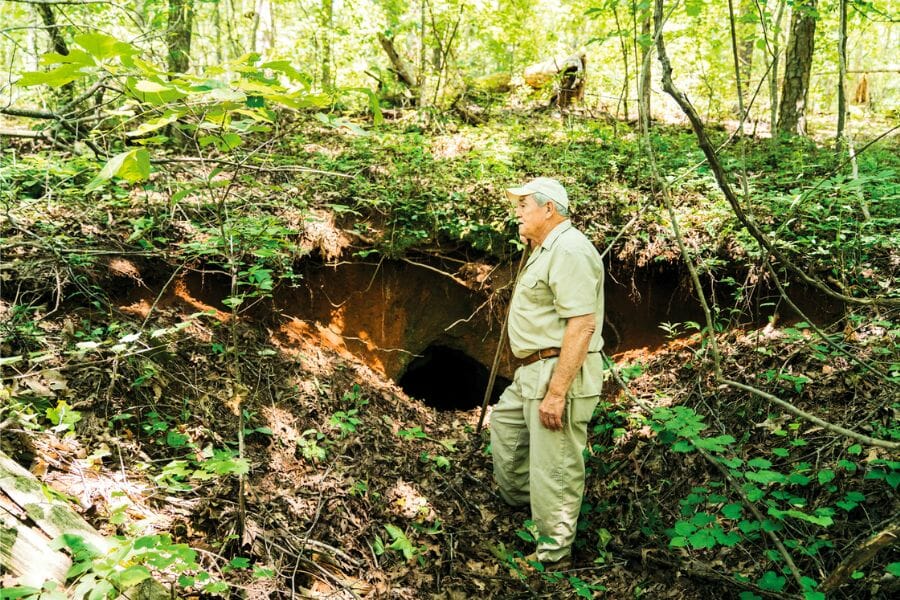
Tallapoosa County, AL
Located in Tallapoosa County, Hog Mountain was once a hub for gold mining in the 1800s. In fact, it’s said that even today, there are still some small gold deposits to be found in the area. But did you know that this mountain also boasts of having beautiful crystals?
Hog Mountain is primarily composed of metamorphic rocks like schist and gneiss. It’s a great spot for crystal hunting because it offers a wide variety of minerals to be found. It’s also home to a wide variety of plant and animal life, making it a scenic and enjoyable place to explore.
Planning your visit here? Head to the town of Alexander City and from there, take Highway 63 to the small town of New Site. Once you’re in New Site, turn onto County Road 83, and follow it until you see the signs for the Hog Mountain Wildlife Management Area. There, you’ll find the entrance to Hog Mountain.
Where we found crystals around Hog Mountain
This location is rich in Galena and Pyrite crystals. You can find them if you explore the northeast portion of Hog Mountain.
Hillabee Creek
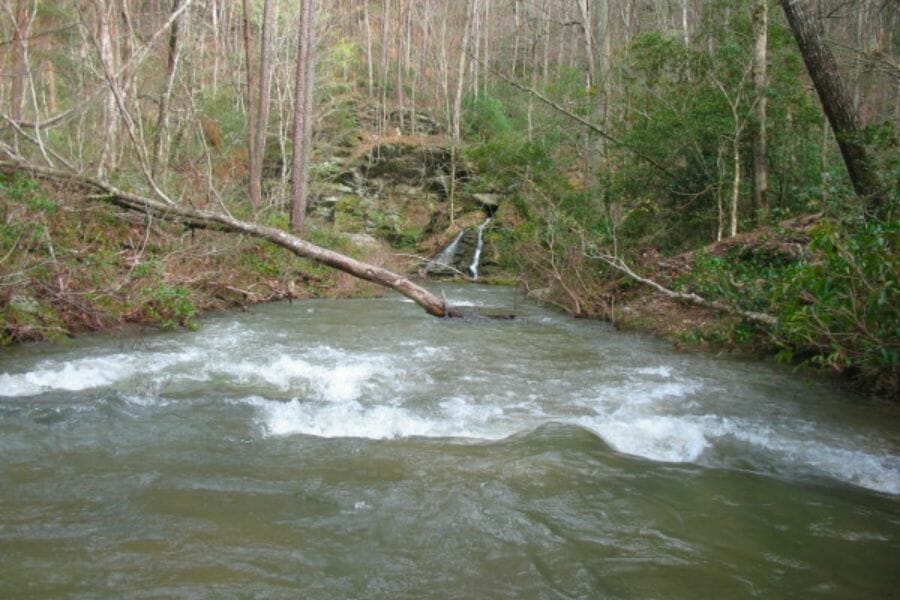
Tallapoosa County, AL
Hillabee Creek was once inhabited by the Creek Indians, and it’s believed that they used the creek as a source of water and to hunt and fish. Today, the creek is known for its beautiful crystals and natural surroundings.
Located in the southern Appalachian Mountains, Hillabee Creek is primarily composed of rocks like granite, gneiss, and schist. These rocks have been subjected to intense heat and pressure over time, creating pockets where minerals have been able to grow.
To go here, head to the town of Alexander City and take Highway 22 east until you reach Hillabee Creek Road. Follow this road until you reach the creek. There are several access points along the creek where you can start your crystal hunting adventure.
Where we found crystals at Hillabee Creek
You can find amazing samples of Chalcopyrite, Copper, and Pyrite crystals when you explore the Childers prospect in the bank of Hillabee Creek.
Tombigbee River
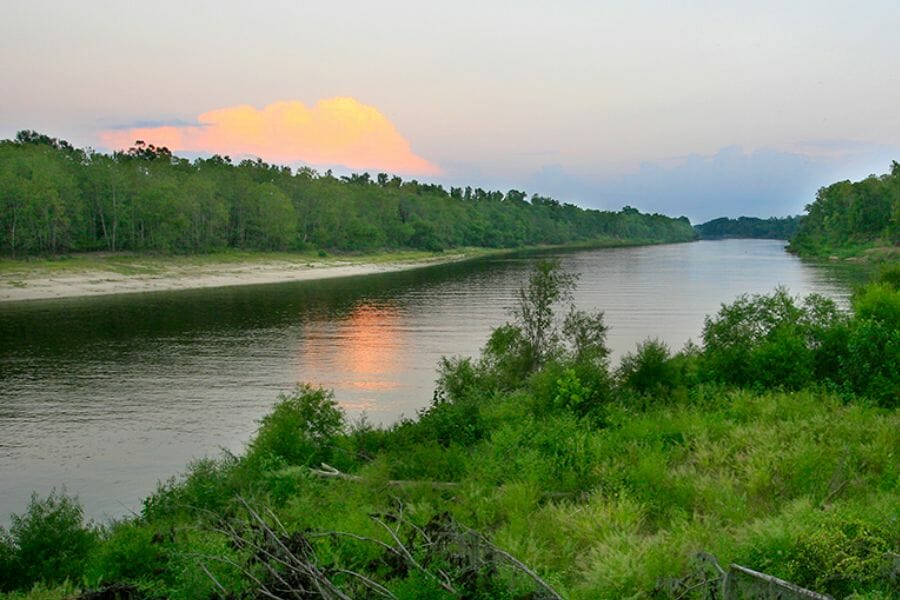
Clarke County, AL
Located in west-central Alabama, Tombigbee River was an important transportation route for Native Americans and European settlers, and it played a key role in the development of the region’s economy and culture.
Tombigbee River is a tributary of the Mobile River, and it runs for approximately 200 miles through Alabama and Mississippi. The area around the river is primarily composed of sedimentary rocks like sandstone and shale, which have been slowly eroded over time by the river’s powerful flow.
Tombigbee River is a fantastic spot for crystal hunting because of the wide variety of minerals you can find there. The river’s powerful flow has exposed many interesting geological formations, and it’s possible to find crystals and minerals embedded in the rocks along the riverbanks.
If you’re keen to visit here, head to the town of Demopolis. From there, you can access the river at several points, including the Demopolis City Landing and the Foscue Creek Park Boat Ramp.
Where we found crystals at Tombigbee River
Truly rich in different crystals, you can find Agate and Chalcedony when you search in the road cuts, clay banks, along nearby Fire Tower road, and in the stream gravels of Tombigbee River and its tributary.
Our Other Favorite Places For Crystal Hunting
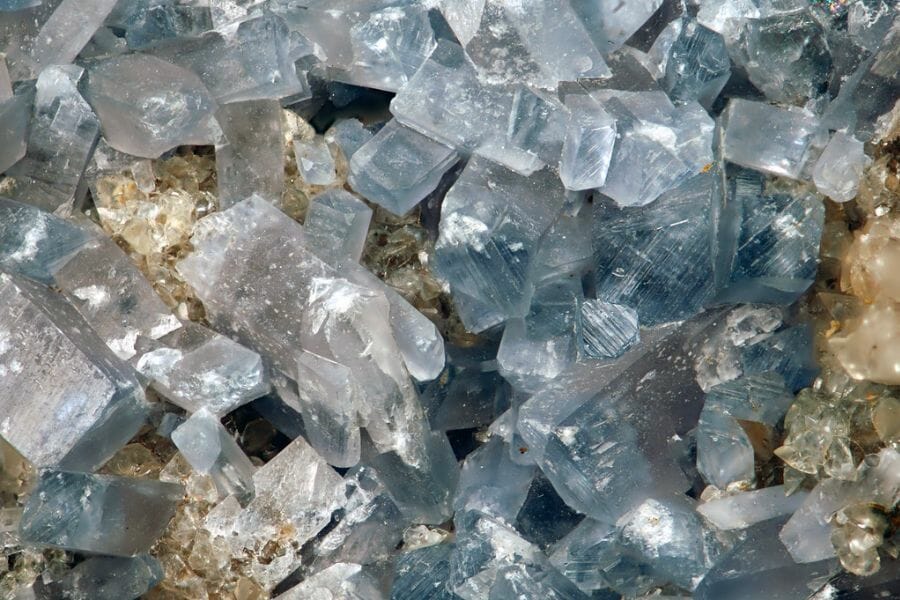
Aside from our top recommendations, there are still tons of different areas that we can share with you. After all, a state as richly endowed as ours will not easily run out of locations for crystal mining. Many of these places are even great sites to find Alabama geodes.
Where you can find crystals for free in Alabama
Let’s discuss first the locations where you can find crystals free of charge. While many of the top sites require fees, there are still plenty astounding spots that you can explore without spending any money.
| County | Location |
| Bibb | Area limestone quarries |
| Blount | In a series of pits and prospects in Blountsville area |
| Chambers | In areas adjacent to the dirt road in Lafayette area |
| Cherokee | On the Lowe farm |
| Elmore | Bluff wall on west bank, in talus, and on water’s edge at Jordan Dam |
| Franklin | Phil Campbell area gravel pits |
| Jackson | At Jacobs Mountain |
| Jefferson | In thin veins in schist of Pleasant Grove Church |
| Madison | Stream gravels, as float |
| Marengo | In Barton’s Bluff area |
| St. Clair | Old copper prospects |
Other great places to dig for crystals
If you’re willing to spend some money in your quest for crystals, then these are some more locations you can consider. The fees may vary depending on the season— sometimes they may even be free— so it’s important to contact them before visiting.
| County | Location |
| Calhoun | In lead and iron mines |
| Clay | In many mica and gold mines, M & G Mine in Ashland, area mines of Cragford, and at Delta Mine |
| Cleburne | At the Stone Hill Copper Mine (aka Woods Copper Mine) |
| Coosa | Countywide old gold mines |
| Randolph | On the dumps of the J. J. New No. 2 Mine |
| Talladega | Ribble’s Mine, Woodford Tract, Storey, Warwick, and Cogburn or Gold Log Mine |
| Tallapoosa | At the Kidd Mine, Mica Hill Mine, and Dudleyville area mine dumps |
The Best Crystal Shops In Alabama

While personally taking the time and effort to find crystals is an activity that’s well worth it, unfortunately, not all of us have the resources to do it. If you prefer visiting just one place but having it all, you may want to consider stopping by the local crystal shops here. You can just imagine how diverse their crystal selections are! Here are some of the best stores here:
- Soulmates Jewelry and Crystals – 55 Co Rd 551, Trinity, AL 35673
- Amethyst Sage – 1809 Hwy 31 SW, Hartselle, AL 35640
- The Brewer’s Alley – Bldg B, 1905 Main St Ste A, Daphne, AL 36526
- Mystical Treasures Emporium – 1500 Mulberry St, Montgomery, AL 36106
- Cosmic Connexion – 814 Annalue Dr, Auburn, AL 36830
- Practical Magick – 1508 6th Ave SE, Decatur, AL 35601
- Hesperia Mystic Shoppe – 4212 N Jackson Hwy, Sheffield, AL 35660
- Yonique Spa & Spiritual Boutique – 5106 McClellan Blvd Suite A, Anniston, AL 36206
- Tie Dye & Crystal Hippy Shop – 5580 Nevius Rd, Mobile, AL 36619
- 4 Fabulous Girls – 300 Hwy 78 E ste b2, Jasper, AL 35501
Additional places to find crystals in nearby states
If you’ve already tried all of our recommendations above or are planning a trip out of the state, you should check out our guides for neighboring states:
If you have any recommendations we haven’t covered, please leave them in the comments below!

